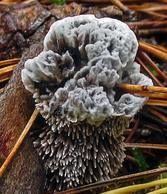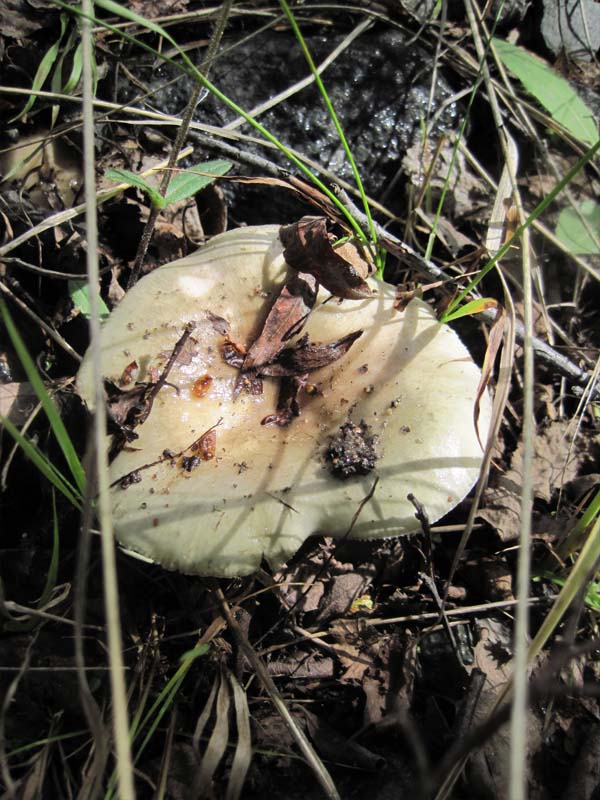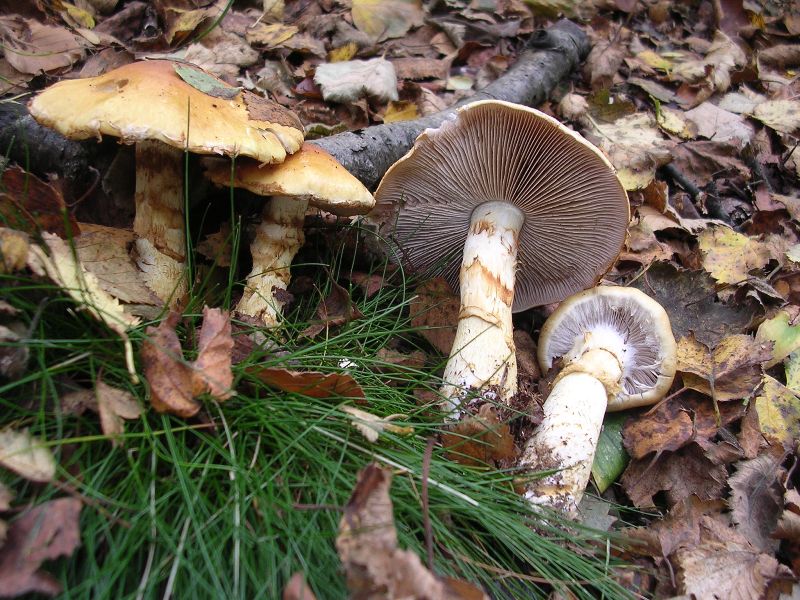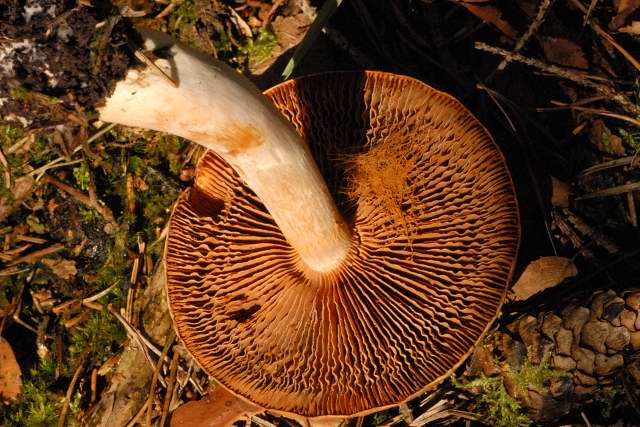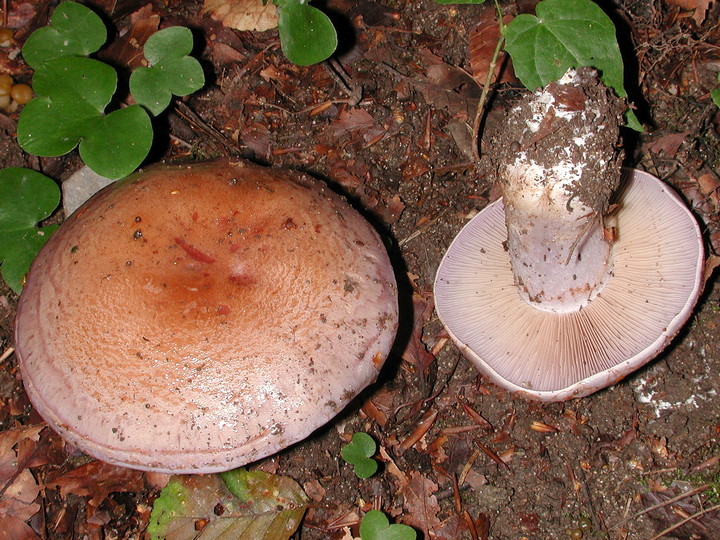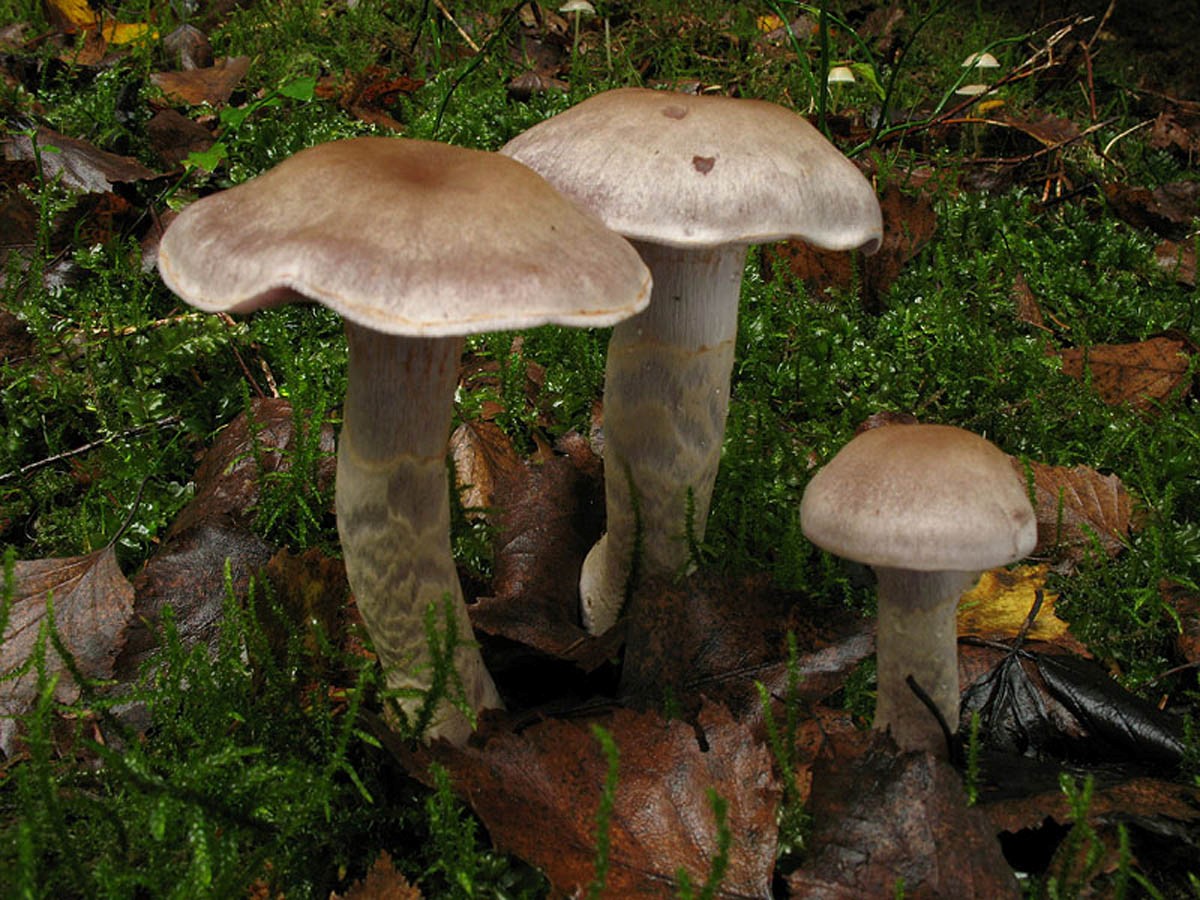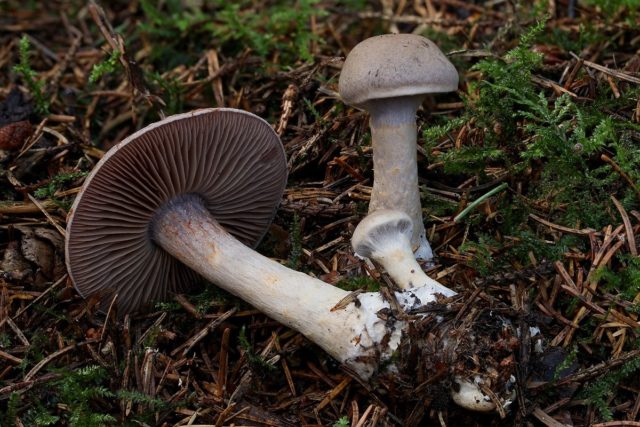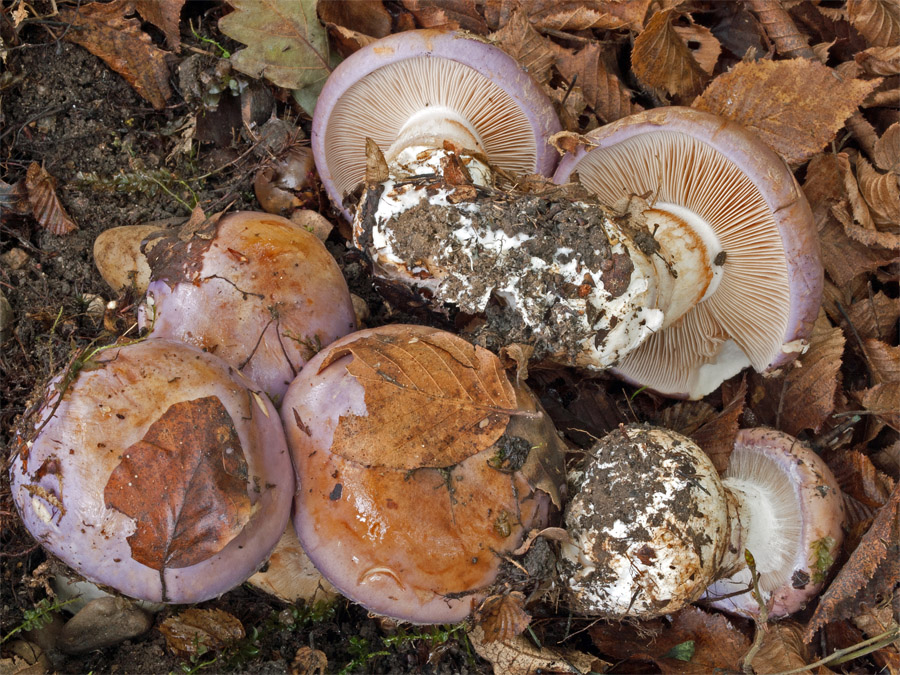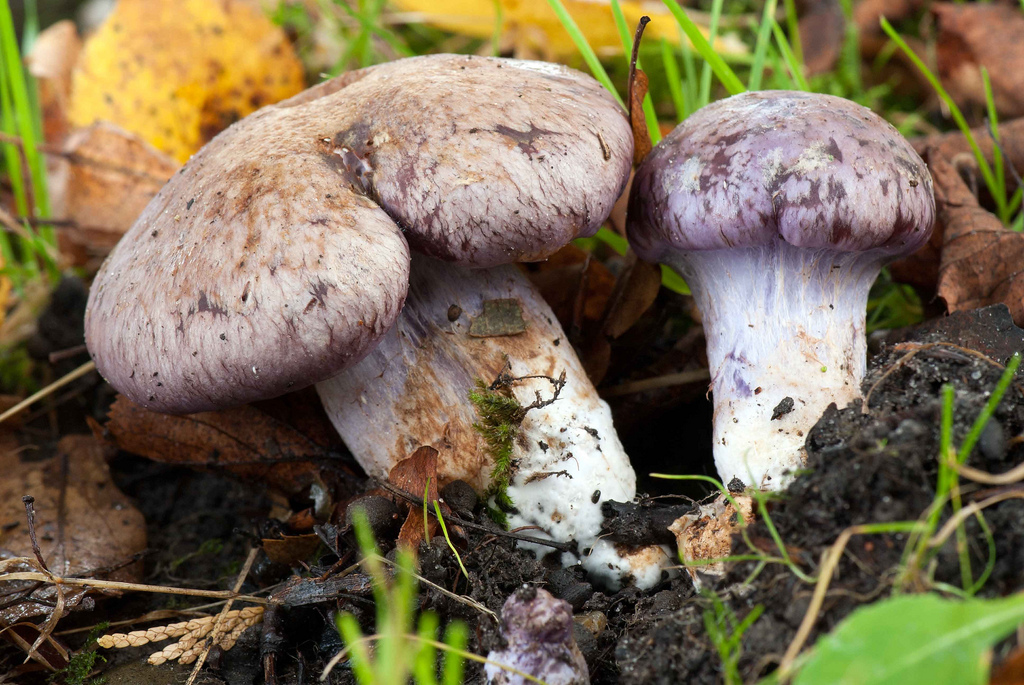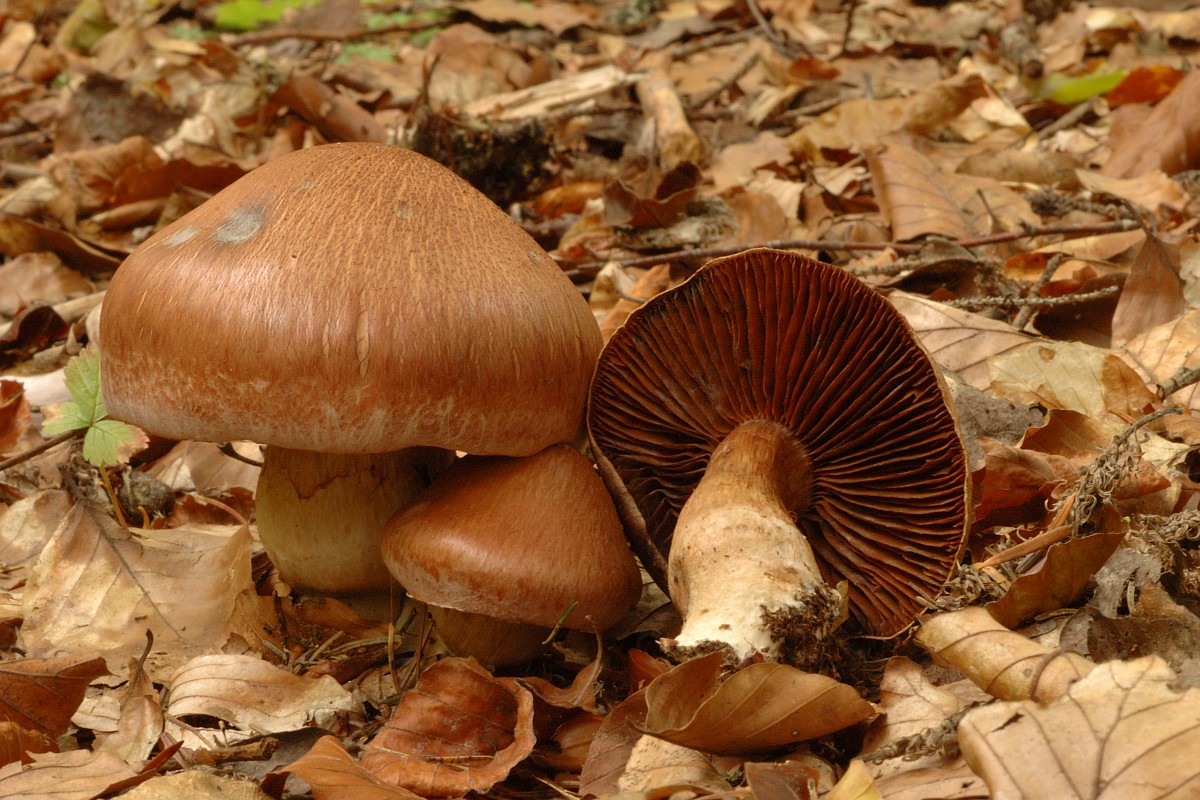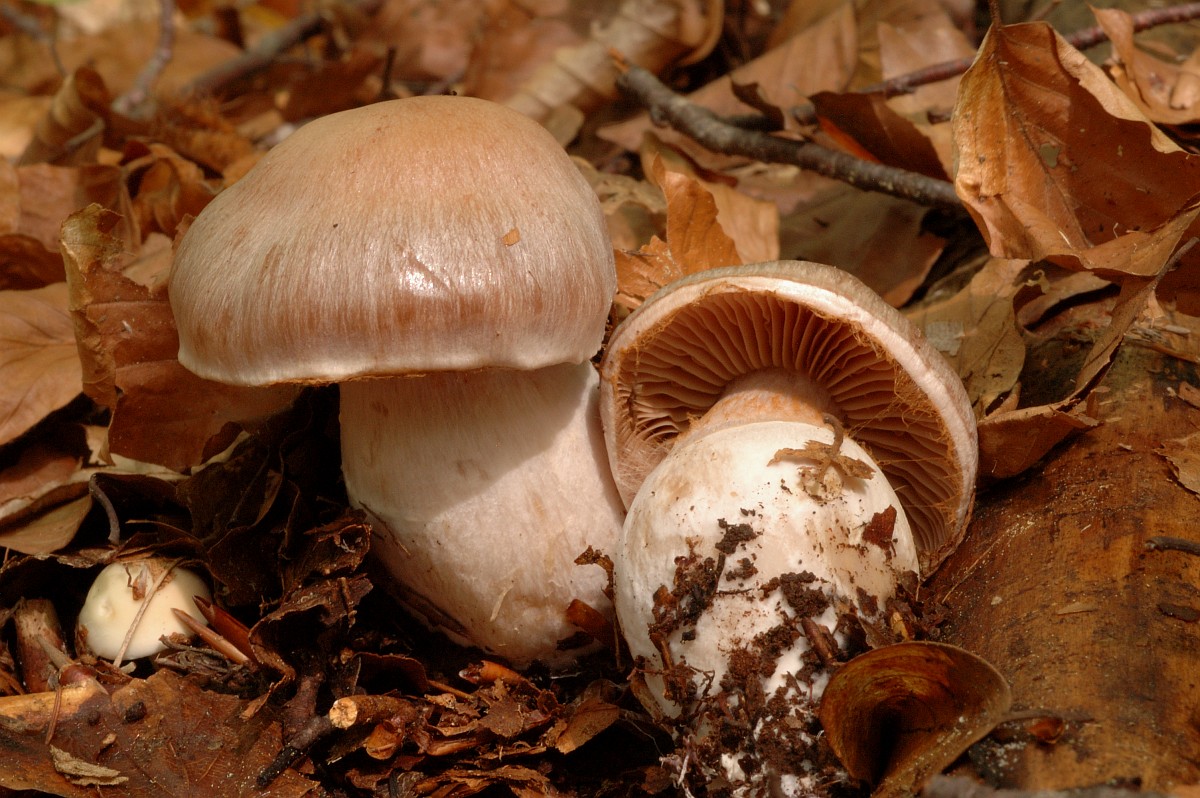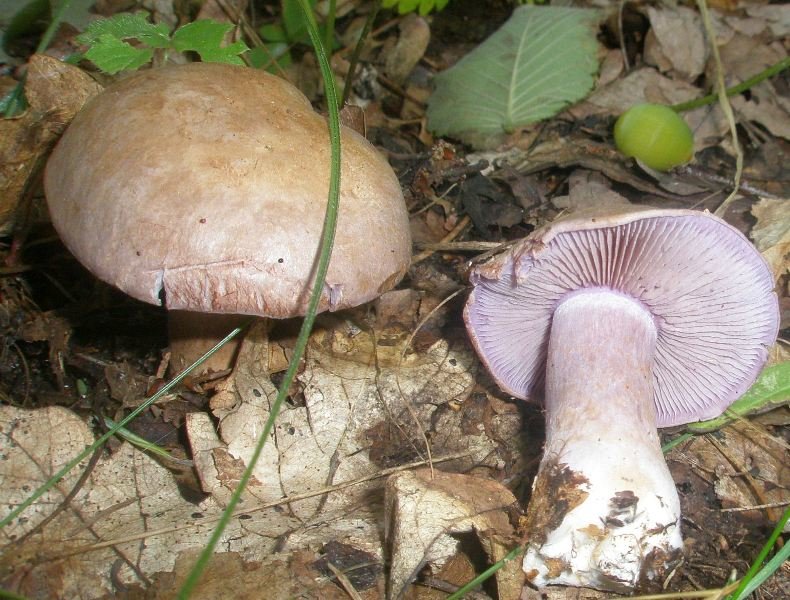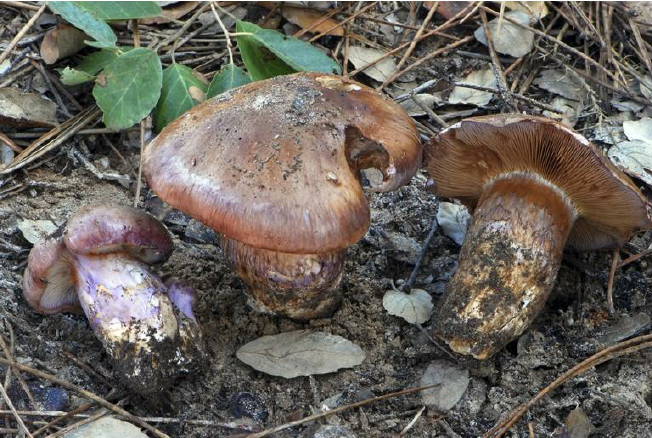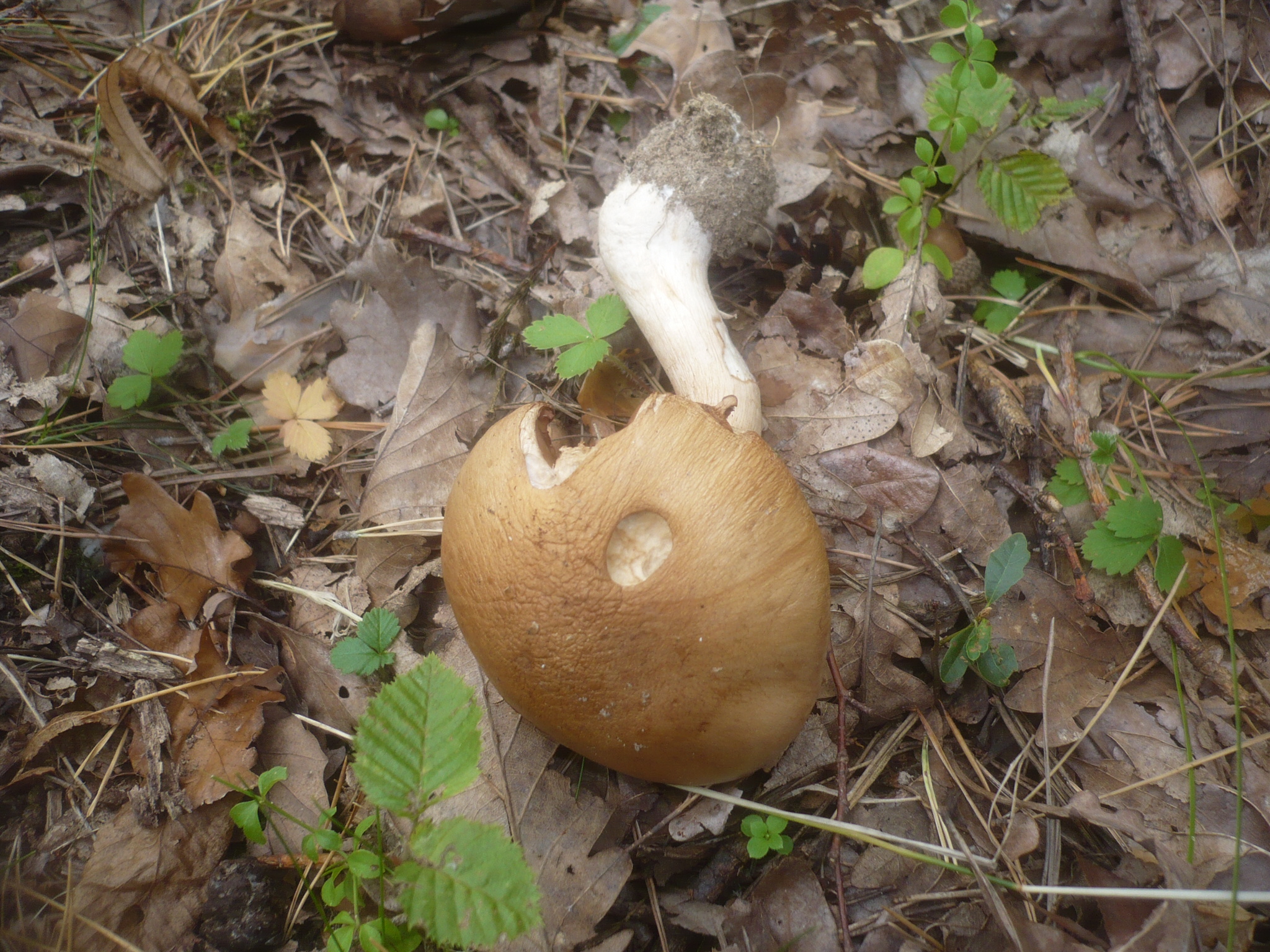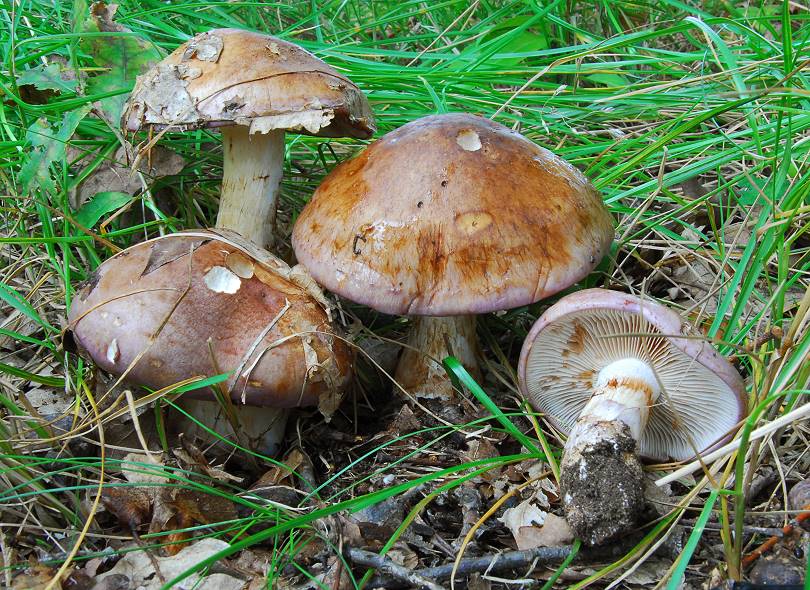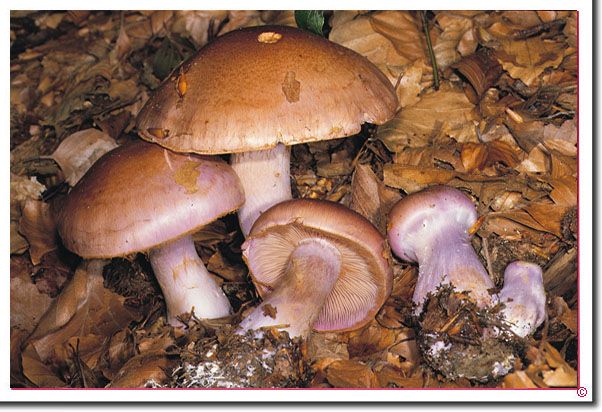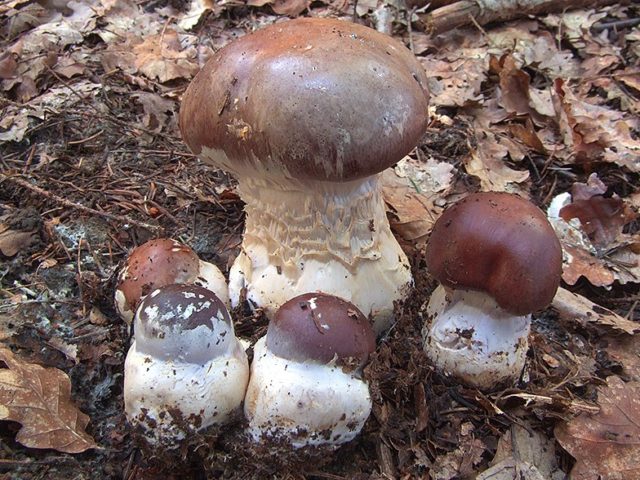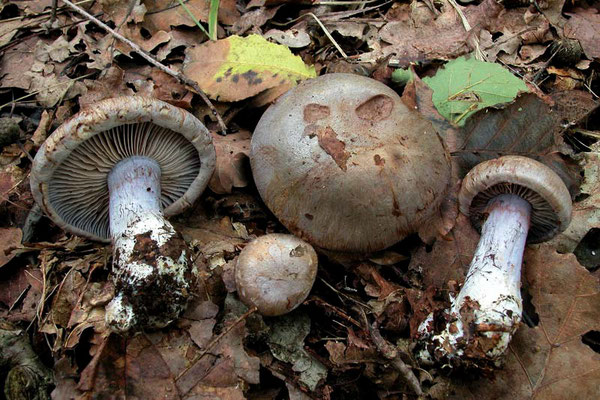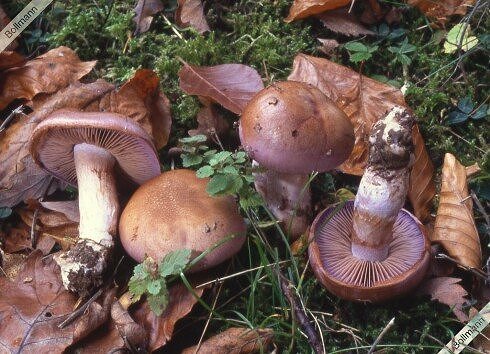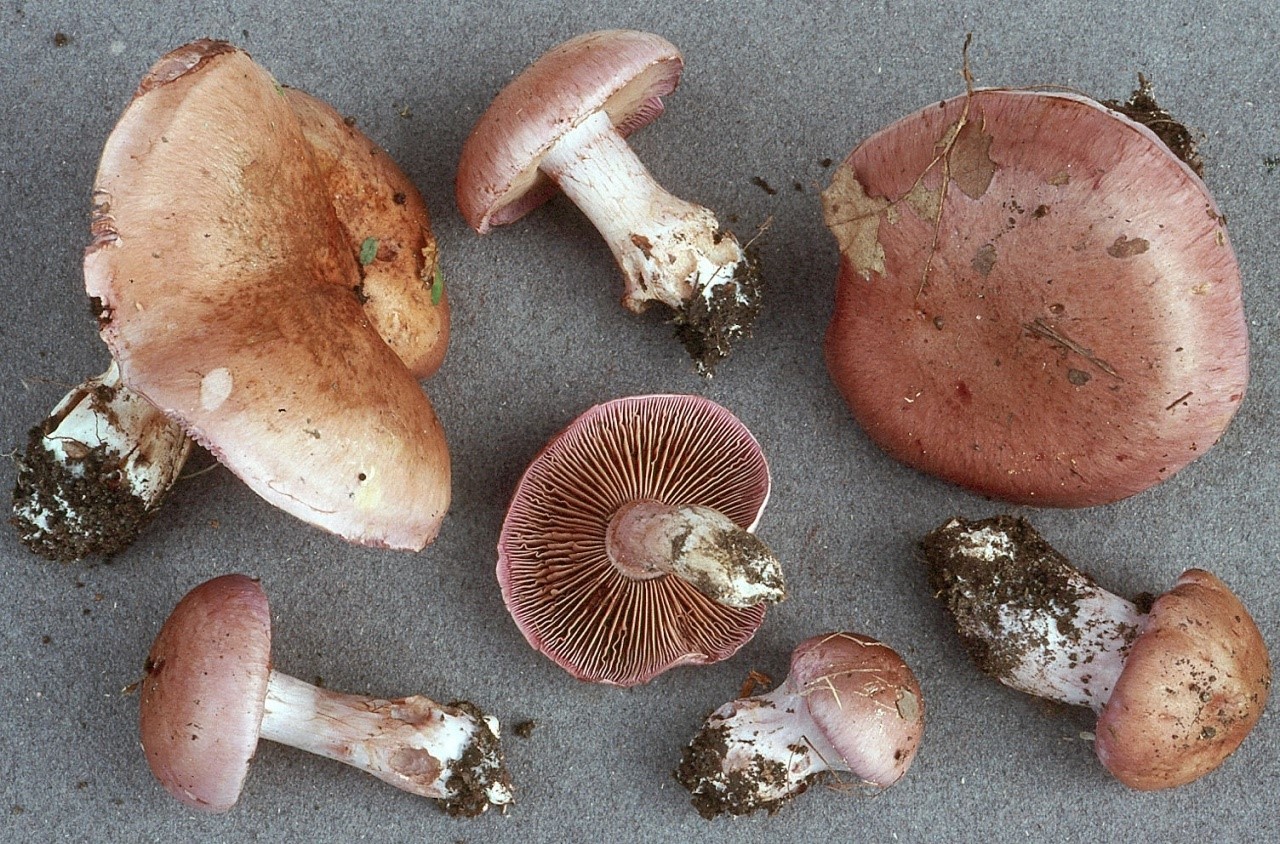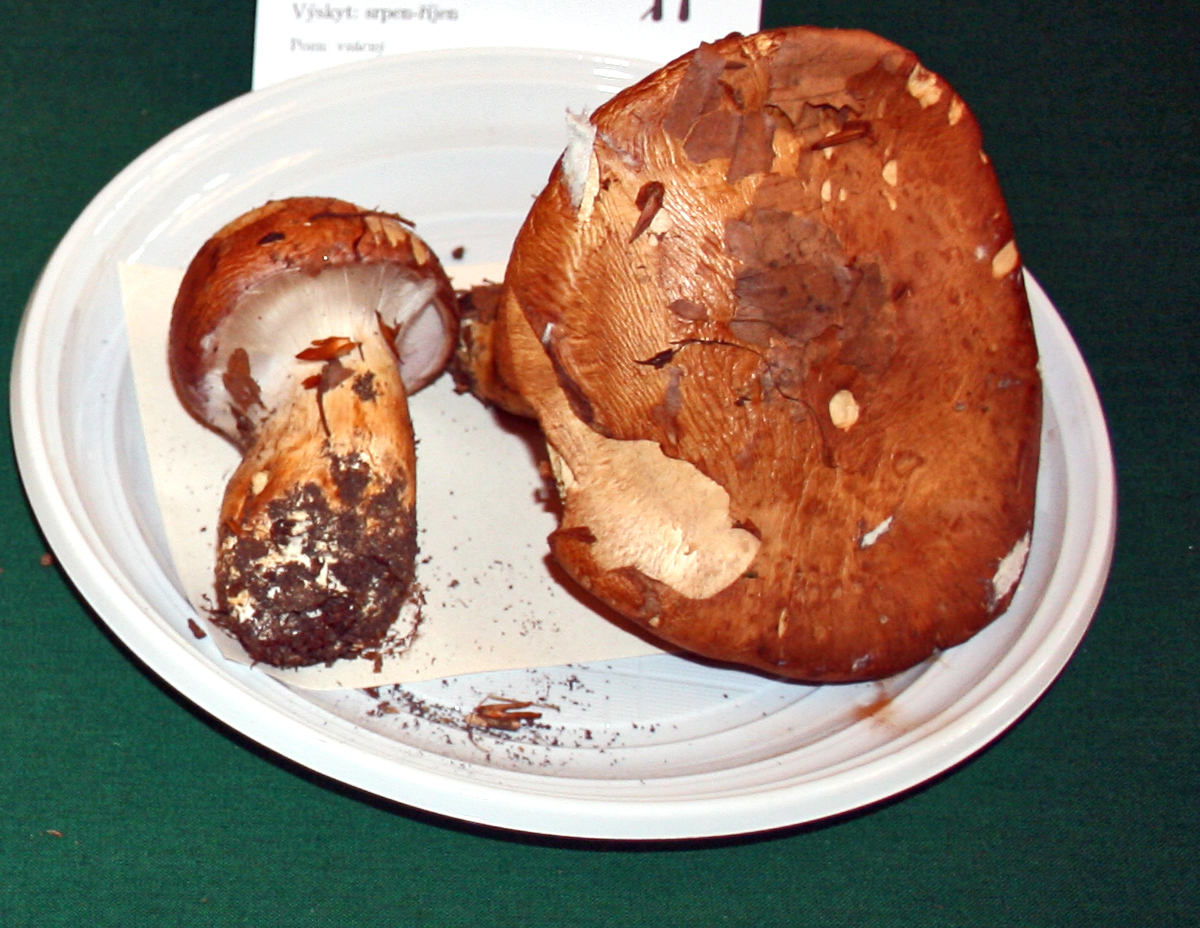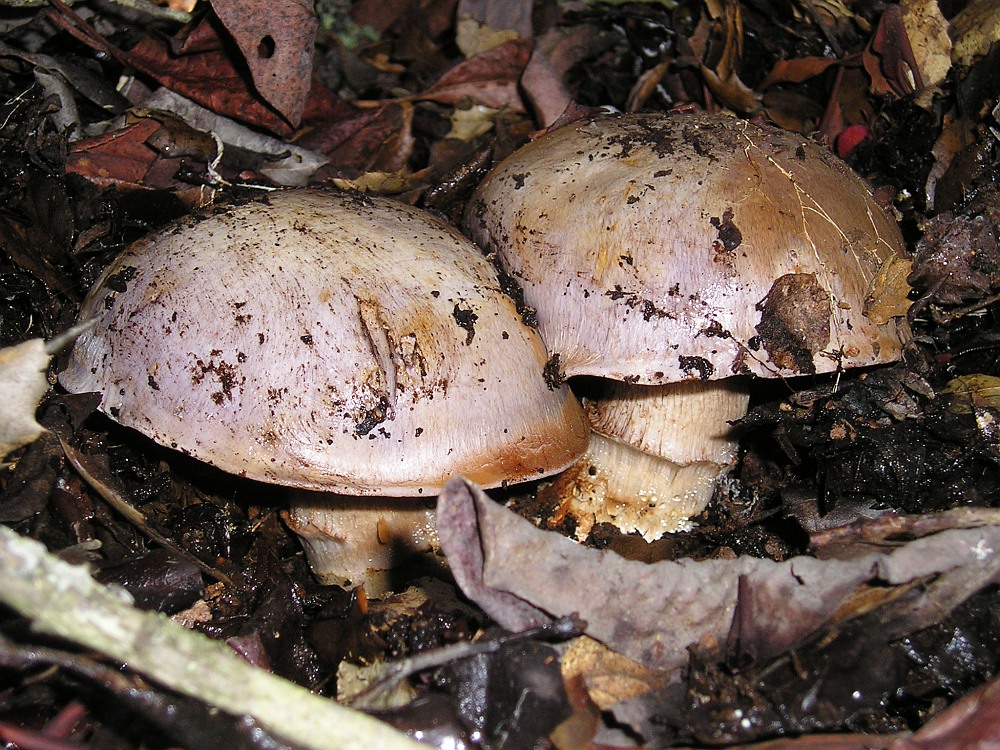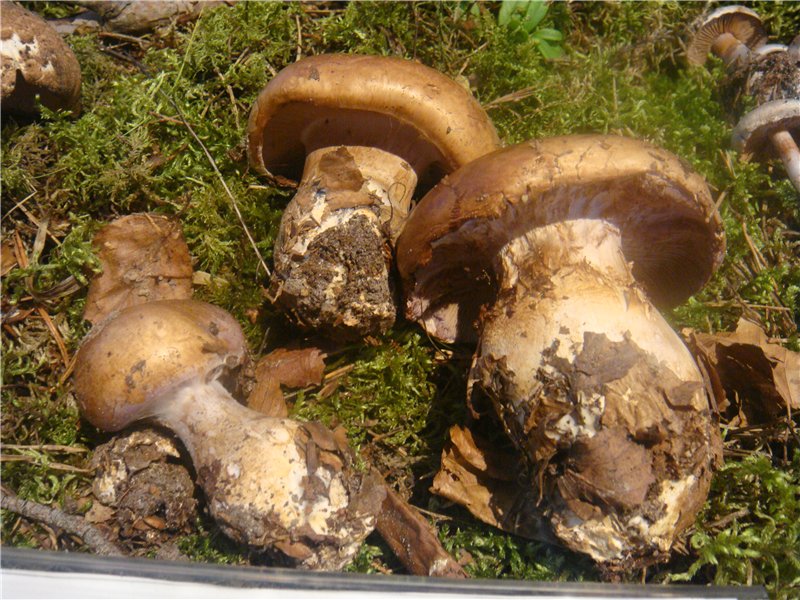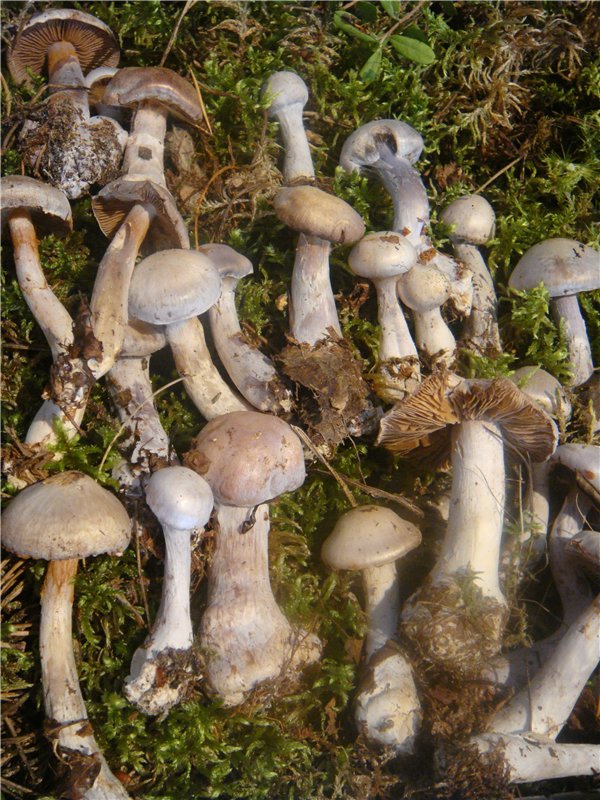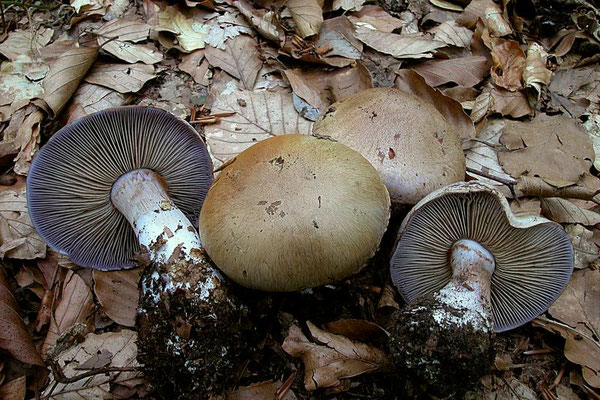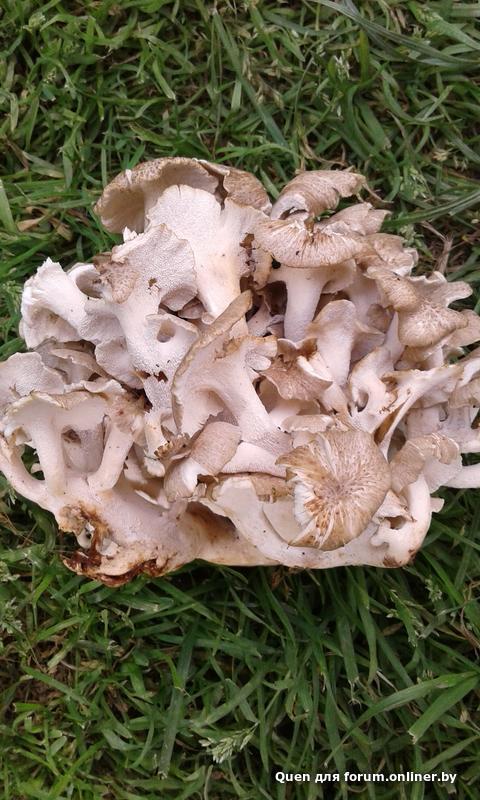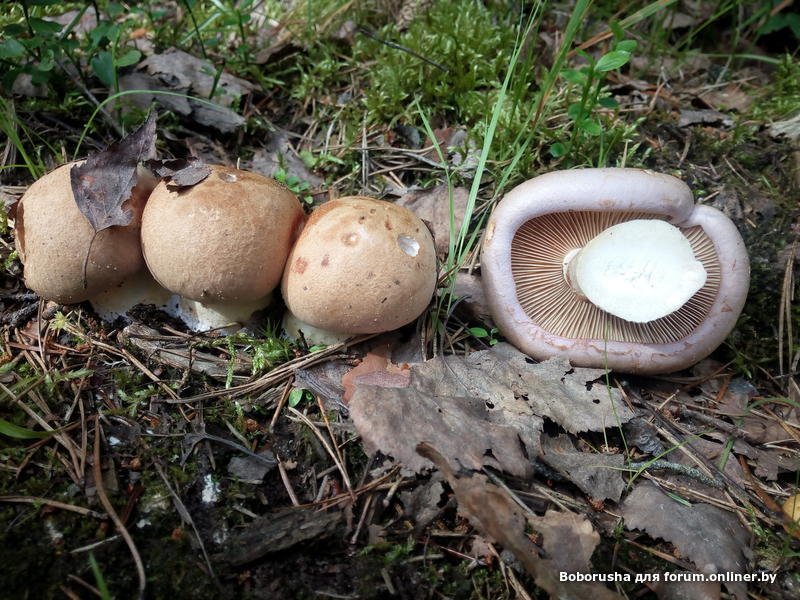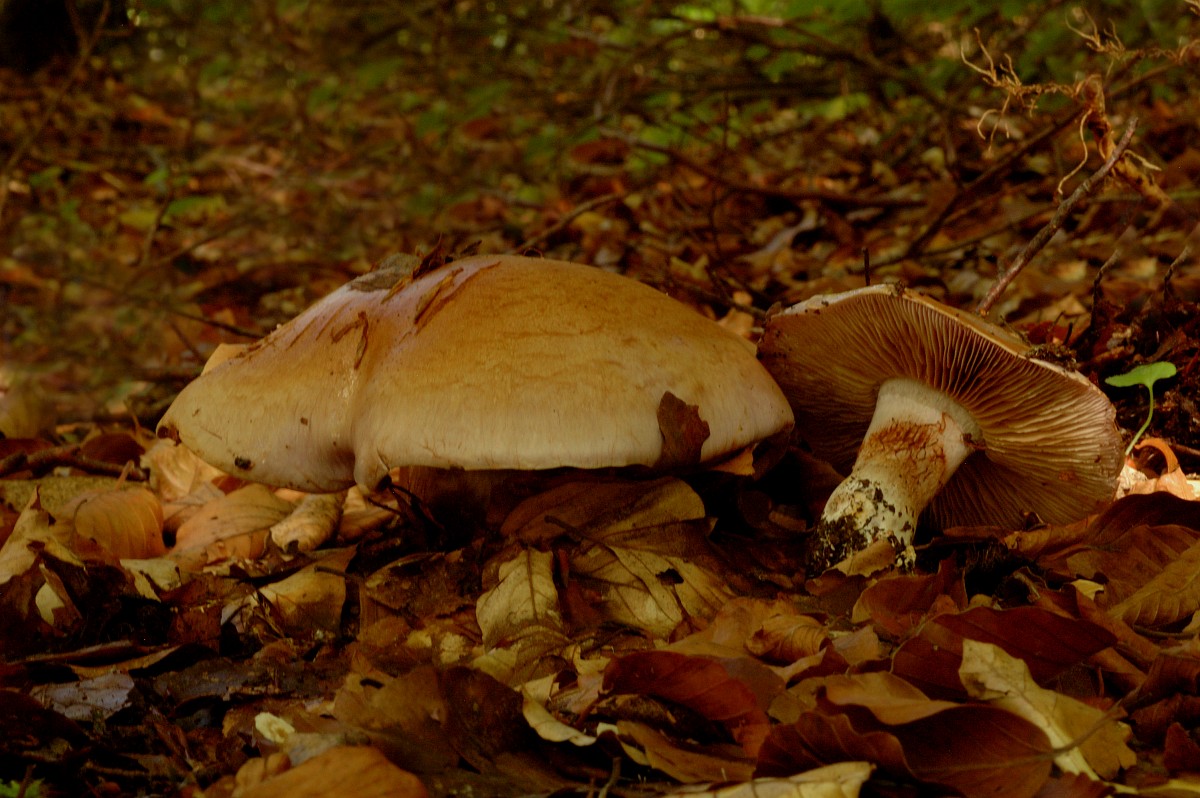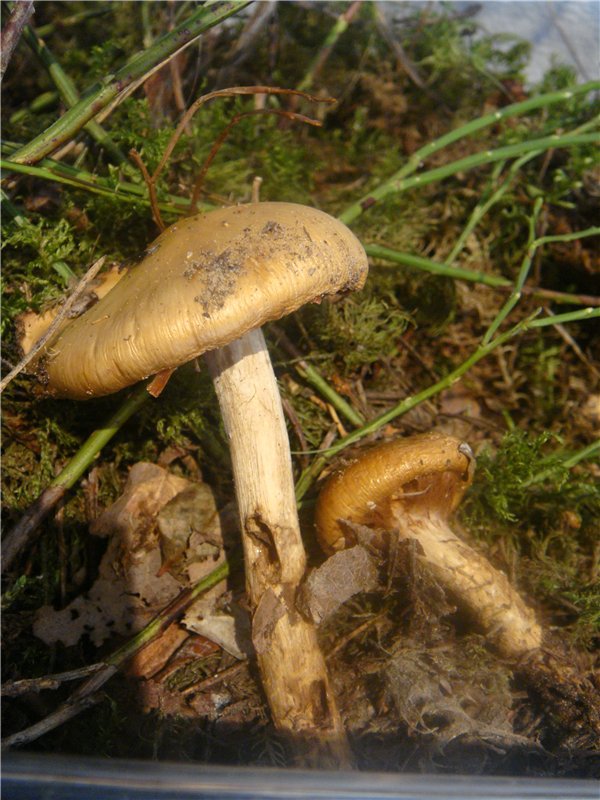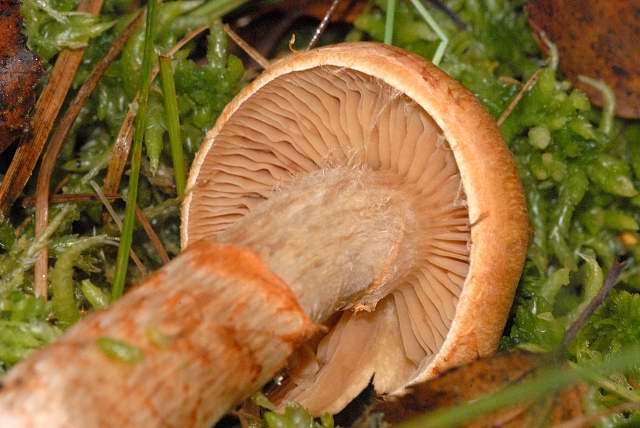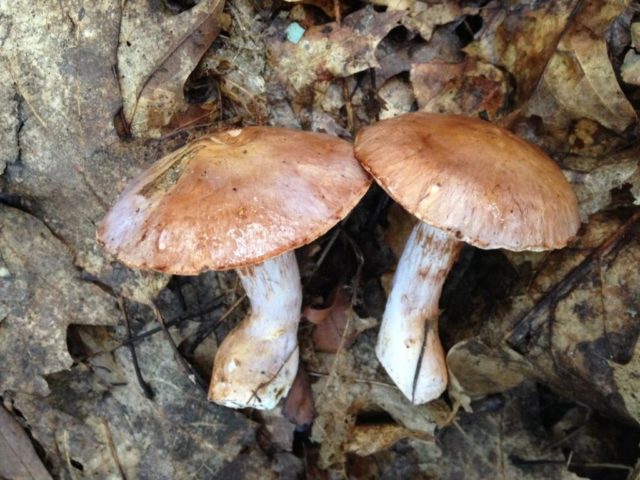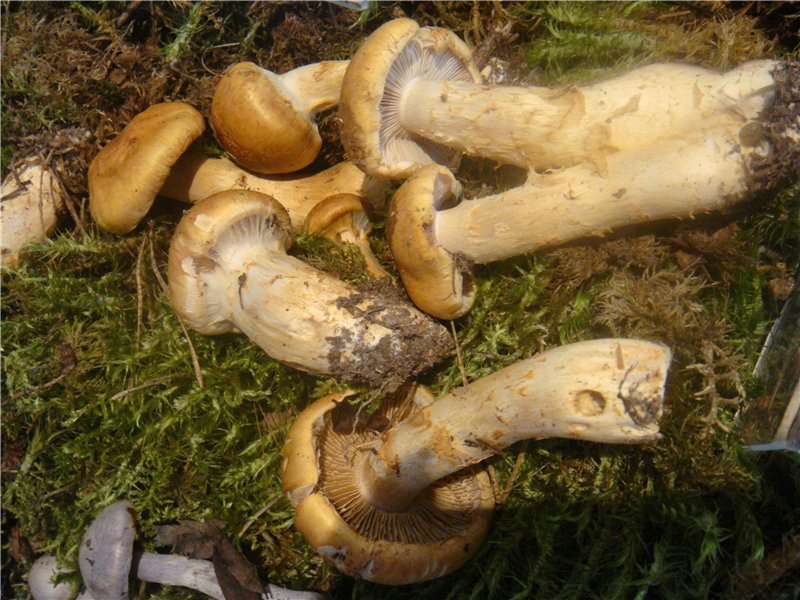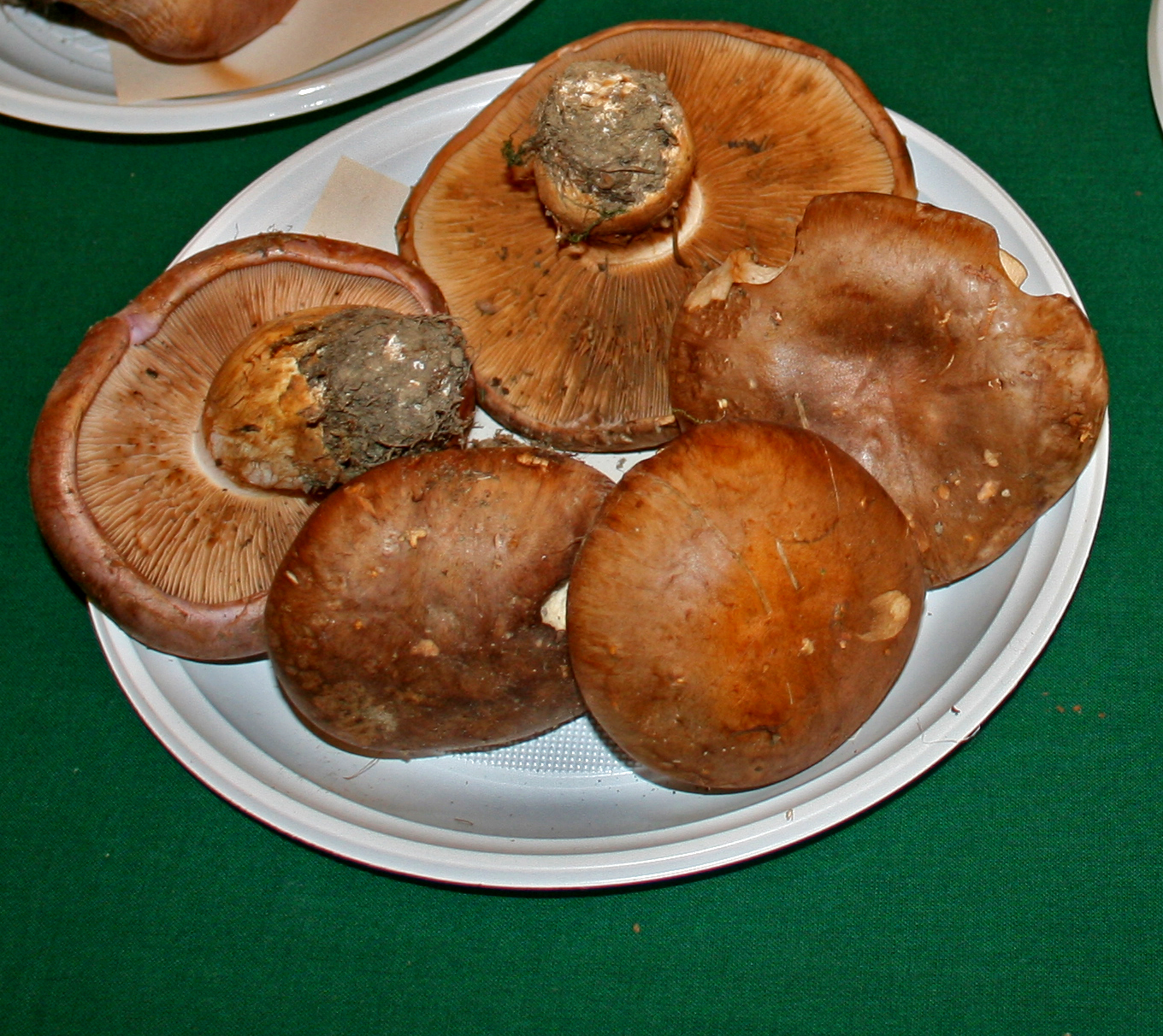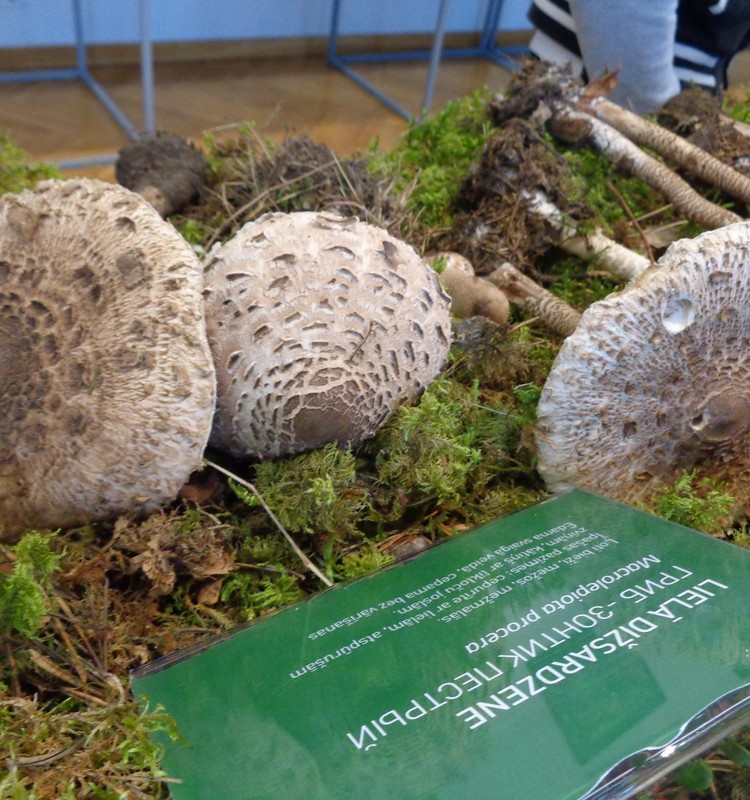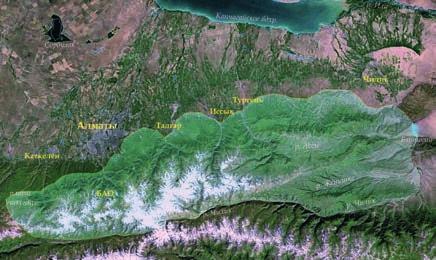White-purple spider web, Cortinarius alboviolaceus
Hat: Medium size (diameter 5-8 cm), fleshy, bell-shaped or hemispherical in youth, as the mushroom matures, it acquires a characteristic half-extended shape with a blunt tubercle in the center. Color - light gray or silvery with a purple tint; the surface is not slimy, smooth, silky, covered with rather rare radial fibers of a more violet color in comparison with the base. The pulp is thick, grayish, friable, with an unpleasant musty smell characteristic of many cobwebs.
Hymenophore: The plates are poorly adherent, of medium frequency, narrow, with frequent veins; in adult mushrooms, they are rusty-brown; in young ones, while covered with a light gray cortina, they are gray-gray, bluish, but already with rusty edges.
Spore powder: Rusty brown.
Leg: Long and powerful (height 6-10 cm, thickness 1.5-2 cm), cylindrical, evenly expanding to the bottom, cap color, often with blue stains. The remnants of the silvery cortina are usually not visible, but when ripening spores fall on it, it becomes rusty-brown in color and becomes very noticeable. The flesh of the leg is gray-bluish, unevenly colored, often watery and friable.
Spreading: The white-purple webcap is found in September-October in deciduous and mixed forests, forming a mycorrhiza with a variety of trees. Prefers moist places, mosses, where it can appear in large quantities.
Similar species: There are many similar mushrooms among the endless genus of spider webs. From more violet varieties such as Cortinarius traganus, the white and purple cobweb is easily distinguished by the color of the cap, which is never so blue; Unlike C. salor, our figurant's leg and cap are not particularly slimy, except maybe rain. How to distinguish Cortinarus alboviolaceus from the silvery spider web, Cortinarius argentatus, does not exist in the popular literature; obviously, one should rely on the presence or absence of blue tones in the color. In general, the distinction of cobwebs, even such noticeable as white and purple, is extremely unpromising.
Edibility: According to literature data, it is not poisonous; according to the same data, it does not bring gastronomic joy to anyone.
Author's notes: The reportable Cortinarius alboviolaceus is another cobweb that can be identified right in the forest with at least some nonzero probability. That's why we love him. If it is, of course, he.
The tubercle is not visible, but it is. The white-purple cobweb is somewhat smaller than most similar blue or purple cobwebs, but in texture this mushroom is not much different from them - the same powerful and lumpy-headed. Under the silvery layer on the cap and stem, the latent blue is clearly visible, which gives a good reason to record this specimen in Cortinarius alboviolaceus.
The plates are brown, and the stripes on the leg are rusty. The rusty stripes on the leg of this white and purple spider web are the remains of a cortina, strewn with spores of the corresponding color. Why are cobwebs good - you don't even need to make an eruption of spore powder, everything is in full view. However, this feature does not help in the definition. Such are the mushrooms - cobwebs. Woven, excuse the expression, of riddles and contradictions.
Big webcap
Large webcap (Cortinarius largus)
Large webcap (Cortinarius largus) is a genus of mushrooms from the Spiderweb family (Kortinariyevs). It, like many other varieties of spiderwebs, is also called a bog.
External description
The cap of the large spider web has a convex-outstretched or convex shape. It is often gray-violet in color.
The flesh of a young fruiting body is purple in color, but gradually turns white. She has no characteristic taste and smell. The lamellar hymenophore consists of plates adherent to the tooth, slightly running down the leg. at first, the plates of the hymenophore are light purple in color, then they become pale brown.The plates are often located, contain a rusty-brown spore powder.
The leg of a large spider web comes from the central part of the cap, has a white or lavender color, which changes to brown towards the base. The leg is solid, filled inside, has a cylindrical shape and a clavate thickening at the base.
Season and habitat
The large cobweb grows mainly in coniferous and deciduous forests, on sandy soils. Very often this type of mushroom can be found on forest edges. Widely distributed in many European countries. The best time to collect a large spider web is the first month of autumn, September, in order to preserve the mycelium, the mushroom must be carefully twisted from the soil, clockwise, when collecting. To this end, the mushroom grabs the cap, turns 1/3 and immediately tilts downward. After that, the fruiting body is straightened again and gently lifted up.
Edibility
The large webcap (Cortinarius largus) is an edible mushroom that can be prepared immediately for consumption, or made from the mushroom for future use (canned, pickled, dried).
Common webcap (Cortinarius trivialis) what it looks like, where and how it grows, edible or not
Common webcap: photo and description
| Name: | Common webcap |
| Latin name: | Cortinarius trivialis |
| Type of: | Inedible |
| Specifications: |
|
| Systematics: |
|
The common webcap (lat.Cortinarius trivialis) is a small mushroom of the Cobweb family. The second name - Pribolotnik - he received for preference to growing conditions. It is found in wet, swampy areas.
A detailed description of the Common Webcap with photos and videos is presented below.
Description of the common webcap
The mushroom was called a cobweb for a kind of "veil" of a cobweb film that is present in young specimens. The rest of the appearance is unremarkable.
Description of the hat
Pribolotnik's cap is small: 3-8 cm in diameter. At the initial stage of development, it has the shape of a hemisphere, which is later revealed. The color of the cap ranges from pale yellow tones to ocher and light brown shades. The core is darker than the edges.
The cap is sticky to the touch, there is a small amount of mucus on it. The surface of the hymenophore is lamellar. In young fruit bodies, it is white, and in mature specimens it darkens to yellowish and brown tones.
The pulp is dense and fleshy, white, with a harsh odor.
Leg description
The leg is 6-10 cm in height, the diameter is 1.5-2 cm. Slightly narrowed towards the base. There are specimens with a reverse structure - there is a small expansion at the bottom. The color of the leg is white, closer to the ground it darkens to a brown tint. Above from the cobweb blanket are brown concentric fibrous bands. From the middle of the leg to the base - weakly expressed.
Where and how it grows
Podbolnik can be found under birches and aspens, rarely under alder. It rarely lives in coniferous forests. Grows singly or in small groups in damp places.
In Russia, the distribution area of the species falls on the middle climatic zone.
Fruiting from July to September.
Edible webcap common or not
The nutritional properties of the Common Webcap have not been studied, but it does not apply to edible mushrooms. This species cannot be eaten.
Related specimens contain dangerous toxins in the pulp.
Poisoning symptoms, first aid
The danger of toxic species of this family is that the first signs of poisoning appear gradually: up to 1-2 weeks after eating mushrooms. Symptoms look like this:
- intense thirst;
- nausea, vomiting;
- stomach ache;
- spasms in the lumbar region.
If you find the first signs of poisoning, you must urgently consult a doctor or call an ambulance. Before receiving qualified treatment, you need to:
- flush the stomach using activated charcoal;
- plentiful drink (3-5 tbsp. boiled water in small sips);
- take a laxative to cleanse the intestines.
Doubles and their differences
The podbolnik is confused with other members of the family, as they are quite similar. The greatest similarity is noted with the mucous webcap (lat.Cortinarius mucosus).
The hat is 5-10 cm in diameter. It has a thin edge and a thick center, abundantly covered with transparent mucus. The leg is slender, cylindrical, 6-12 cm long, 1-2 cm thick.
It differs from Pribolotnik in abundant mucus and the shape of a cap.
Grows in coniferous and mixed forests under pine trees. Bears fruit singly.
The slime webcap (lat.Cortinarius mucifluus) is another twin of the Pribolotnik, which is confused with the mucous webcap because of a similar name. The hat with a diameter of 10-12 cm is abundantly covered with mucus. The stem is 20 cm long in the form of a spindle, also covered with mucus. Prefers coniferous forests.
It differs from Pribolotnik in abundant mucus and a longer leg.
Conclusion
The common webcap is an inedible mushroom, its properties have not been fully studied. Can be confused with other members of the family, the use of which is not recommended. The greatest similarity is noted with the Slime Webcap and the Slime Webcap, but they can be distinguished by their cap. In the latter, it is abundantly covered with mucus.
Additional information about the common webcap:
Classification and representatives
Main article: Taxa of the genus Spiderweb
On the basis of macroscopic, microscopic and chemical characters, the genus is divided into 4-7 taxa, which were previously considered as subgenera or sections; in new systems, subgenera are divided into a large number of sections.
In 1821 E. Fries divided the genus into 6 subgenera: Myxacium, Phlegmacium, Inoloma (= Cortinarius sensu stricto), Dermocybe, Telamonia and Hydrocybe... Moser in 1955, taking the Fries system as a basis, identified 5 independent genera, but he (together with Singer) in 1962 again lowered their rank to subgenera, with changes in their composition.This classification is also adopted in new systems, but the assignment of species to subgenera can vary considerably among different authors.
Cortinarius - one of the largest genera of the Agarikov order. Different authors indicate a different number of species in the genus, usually up to 700, but according to the most complete edition - "Dictionary of mushrooms", the number of species exceeds 2000.
Subgenera (according to Nezdoyminy (1996), corresponds to the Moser - Singer system (1962)):
- Phlegmacium (Fr.) Fr.
- Sericeocybe P.D. Orton
- Myxacium (Fr.) Loud.
- Telamonia (Fr.) Loud.
- Leprocybe Mos.
- Cortinarius
- Dermocybe (Fr.) Sacc.
Some species:
| Cat. * | Latin name | Russian name | ||||||||||
|---|---|---|---|---|---|---|---|---|---|---|---|---|
| Cortinarius alboviolaceus | Webcap white-purple | |||||||||||
| Cortinarius balteatocumatilis | Webcap bluish belted | |||||||||||
| Cortinarius anomalus | The webcap is abnormal | |||||||||||
| Cortinarius anserinus | Goose webcap | |||||||||||
| Cortinarius armillatus | Bracelet webcap | |||||||||||
| Cortinarius auroturbinatus | Beautiful clubfoot webcap | |||||||||||
| Cortinarius bolaris | Lazy webcap, or red-scaly, or hulk webcap | |||||||||||
| Cortinarius camphoratus | Webcap camphor | |||||||||||
| Cortinarius cinnamomeus | Cinnamon webcap | |||||||||||
| Cortinarius collinitus | Blue-bore webcap | |||||||||||
| Cortinarius cotoneus | Wadded webcap | |||||||||||
| Cortinarius crassus | Thick-fleshy webcap | |||||||||||
| Cortinarius cumatilis | Spider web is watery blue, or gray-blue | |||||||||||
| Cortinarius elegantior | The webcap is elegant | |||||||||||
| Cortinarius elegantissimus | The most elegant webcap | |||||||||||
| Cortinarius evernius | The webcap is brilliant | |||||||||||
| Cortinarius herculeus | Webcap of Hercules | |||||||||||
| Cortinarius largus | The webcap is large, or abundant | |||||||||||
| Cortinarius limonius | Cobweb lion-yellow | |||||||||||
| Cortinarius mucosus | Slimy webcap | |||||||||||
| Cortinarius multiformis | Diverse webcap | |||||||||||
| Cortinarius odorifer | Anise webcap | |||||||||||
| Cortinarius orellanus | Mountain webcap, or plush, or orange-red, or poisonous | |||||||||||
| Cortinarius paleaceus | Filmy webcap | |||||||||||
| Cortinarius phoeniceus | Cobweb purple | |||||||||||
| Cortinarius pholideus | Scaly webcap | |||||||||||
| Cortinarius praestans | The webcap is excellent | |||||||||||
| Cortinarius purpurascens | The webcap is crimson, or reddish | |||||||||||
| Cortinarius rubellus | Reddish cobweb | |||||||||||
| Cortinarius rufoolivaceus | Red & olive spiderweb | |||||||||||
| Cortinarius sanguineis | Webcap blood red | |||||||||||
| Cortinarius semisanguineus | Webcap half-blood red | |||||||||||
| Cortinarius sodagnitis | The cobweb is recognizable | |||||||||||
| Cortinarius speciosissimus | The webcap is beautiful | |||||||||||
| Cortinarius splendens | The webcap is shiny | |||||||||||
| Cortinarius terpsichores | Webcap of Terpsichore | |||||||||||
| Cortinarius torvus | Gloomy webcap | |||||||||||
| Cortinarius traganus | Goat's webcap, or lilac thick-legged | |||||||||||
| Cortinarius triumphans | Triumphal webcap | |||||||||||
| Cortinarius trivialis | Common webcap | |||||||||||
| Cortinarius variecolor | Multi-colored webcap | |||||||||||
| Cortinarius varius | Changeable webcap, or brick-yellow | |||||||||||
| Cortinarius violaceus | Webcap purple | |||||||||||
|
Description of the mushroom
The common webcap, called in Latin Cortinarius trivialis, belongs to the family of Webcaps (or Cortinaria) and the genus Webcaps (agaric order). It is popularly known as Pribolotnik, as it grows mainly in wet areas. It acquired its name thanks to a kind of cobweb blanket, reminiscent of a veil-like film, which connects the edges of the cap with the leg. And the epithet "ordinary" symbolizes the classic, usual structure of the fruiting body and inexpressive color.
The cap of the mushroom reaches a diameter of 3 to 8 cm. In immature representatives of the species, it has a hemispherical, rounded-bell-shaped shape with curved edges. As the fungus grows, it becomes convex-outstretched with a wide, low tubercle in the center. At the same time, a small amount of mucus can be seen on the surface of the cap. The color varies from pale yellow or pale ocher with an olive tint to clay, honey brown and yellow brown. There are also fruiting bodies with a red-brown cap in the center and light edges.
The hymenophore (the lower part of the cap, on the surface of which there is a thin spore-bearing layer) is distinguished by wide, often located to each other, plates that grow together in the form of a tooth. In young mushrooms, this part has a yellow or whitish color, and in more mature ones, it is rusty brown or pale ocher. Also on the hymenophore, a barely noticeable cobweb cover of a whitish color with a mucous consistency is visible. The spore powder in the common spider web is yellowish-brown.
On the cut, the flesh of the mushroom is quite dense, ocher color (sometimes it acquires a light whitish tint), and closer to the base of the leg it becomes slightly brownish. The smell of the fruiting body is unpleasant, and the taste is inexpressive.
The leg of the common spider web is silky and dense. It has a cylindrical shape that tapers or sometimes widens towards the base. Its height is 5-10 cm, and its diameter is no more than 1-2 cm. In young representatives of the species, it is initially solid, and later becomes complete. The color of the leg is white, sometimes with a purple tint, brownish in the base area. The girdle on the stem resembles concentric fibers of yellow-brown and brown shades.
Dubravny webcap (changing): photo and description
| Name: | Oak cobweb |
| Latin name: | Cortinarius nemorensis |
| Type of: | Inedible |
| Synonyms: | Changing webcap, Phlegmacium largum, Phlegmacium nemorense |
| Systematics: |
|
Dubravny spiderweb is an inedible representative of the Spiderweb family. Grows in large groups in deciduous forests. Fruiting during the entire warm period. Since the species is not used in cooking, it is necessary to familiarize yourself with the external characteristics, view photos and videos.
What does a cobweb look like
Oak cobweb - lamellar mushroom. Acquaintance with him must begin with a description of the cap and leg.
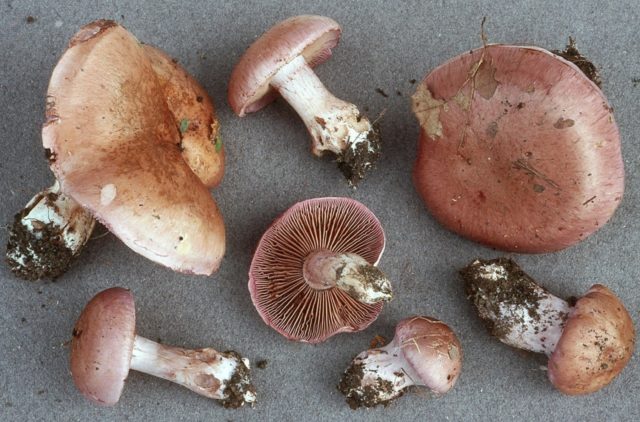
In young species, the bottom layer is covered with a thin cobweb.
Description of the hat
The cap in young specimens is hemispherical; as it grows, it straightens, becomes semi-convex and reaches 13 cm.The surface is covered with a silky skin, which is covered with mucus on a rainy day. The young fruiting body is colored light purple; with age, the color changes to red-chocolate, with a pronounced lilac tint.
The whitish or light purple flesh has an unpleasant odor and insipid taste. On contact with alkali, the color changes to bright yellow. The lower layer is formed by small, partially adherent plates, light purple in color.As they grow older, the plates change color to coffee. Reproduction occurs by elongated spores, which are located in a dark powder.
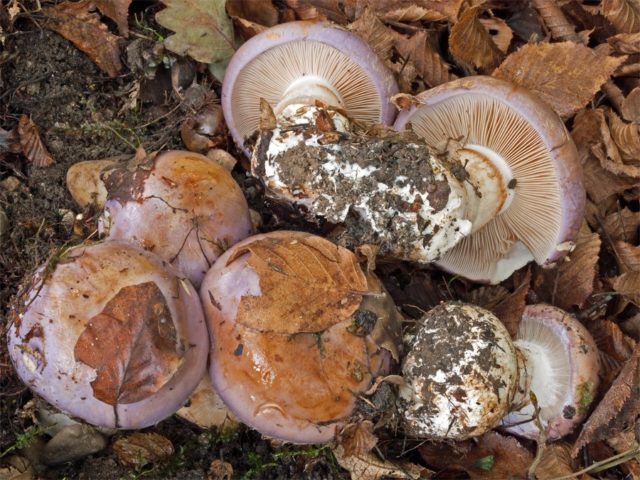
The hemispherical cap partially straightens over time
Leg description
The oak cobweb has a dense, cylindrical leg 6-10 cm high. The surface is light purple or brown in color, sometimes flakes from a torn bedspread can be seen on it.

The elongated leg thickens towards the base
Where and how it grows
The oak webcap prefers to grow among broad-leaved trees in large families. Often found in the Moscow region, in the Krasnodar and Primorsky Territories. Fruiting from July until the first frost.
Is the mushroom edible or not
The cobweb is an inedible species. Due to the unpleasant aroma and insipid taste, the mushroom is not used in cooking. But if this forest dweller somehow got on the table, he will not bring severe harm to the body, since there are no toxic and poisonous substances in the pulp. Intoxication can only be in people with weakened immunity in the form of nausea, vomiting and diarrhea.
Doubles and their differences
The oak webcap, like any inhabitant of the forest, has similar twins, such as:
- Bluish Belted is an inedible species that grows in deciduous forests from August to October. It can be recognized by its grayish-brown cap and mucous stalk. The pulp is tasteless and odorless. Since this species is not eaten, it is better to pass by when found.
- Excellent or Gorgeous - Conditionally edible forest dweller. The mushroom has a small, hemispherical surface, chocolate-purple in color. The pulp is firm, with a pleasant taste and aroma; in contact with alkali, it acquires a brown color. After a long boiling, the mushroom harvest can be fried, stewed, preserved.
- Stepson is a poisonous mushroom that, when eaten, causes severe food poisoning. You can recognize the species by the bell-shaped cap, up to 7 cm in size. The surface is velvety, copper-orange in color. The spore layer is formed by adherent chocolate plates with whitish jagged edges. White pulp, tasteless and odorless. Since a mushroom can cause irreparable harm to health, when meeting with it, it is better to pass by.
Conclusion
Oak cobweb is a common species. Prefers to grow in deciduous forests all summer long
Since the species is not eaten, it is important to know the external characteristics and view the photo
Crimson webcap (Cortinarius purpurascens)
Scarlet webcap (Cortinarius purpurascens) - a mushroom, which according to some sources belongs to the edible, belongs to the Spiderweb genus, the Cobweb family. The main synonym for its name is the French term Cortinarius purpurascens.
External description
The fruit body of the crimson spider web consists of a leg 6 to 8 cm long and a cap, the diameter of which is up to 15 cm. Initially, the cap has a convex shape, but in ripening mushrooms it becomes prostrate, sticky to the touch and flat. The flesh of the cap is characterized by its fiber, and the color of the cap itself can vary from olive brown to reddish brown, with a slightly darker color in the central part. When the pulp dries, the cap ceases to shine.
The mushroom pulp is characterized by a bluish tint, but upon mechanical action and cutting it acquires a purple color. The pulp of this mushroom, as such, has no taste, but the aroma is pleasant.
The girth of the mushroom stalk varies within 1-1.2 cm, the stalk is very dense in structure, at the base it acquires a tuberous swollen shape. The main color of the stem of the mushroom is purple.
The hymenophore is located on the inner surface of the cap, and consists of plates adhered to the pedicle with a tooth, initially having a purple color, but gradually becoming rusty-brown or brownish. The plates contain a spore powder of rusty-brown color, consisting of almond-shaped spores covered with warts.
Season and habitat
Active fruiting of the crimson spider web occurs in the autumn period. The fungus of this species can be found in mixed, deciduous or coniferous forests, mainly at the end of August and throughout September.
Edibility
Information about whether the crimson cobweb is edible is controversial. Some sources say that this type of mushroom is allowed to be eaten, while others indicate that the fruiting bodies of this mushroom are not suitable for eating, since they have low taste. Conventionally, the crimson spider web can be called edible, mainly it is eaten salted or pickled. The nutritional properties of the species have been little studied.
Similar types and differences from them
The scarlet spider web is similar in appearance to some other types of spider web. The main distinguishing features of the species is the fact that the flesh of the described mushroom, under mechanical action (pressure), changes its color to bright purple.
Description
Lamellar cap mushroom with a cobweb blanket. The cap of adult mushrooms reaches 5-13 cm in diameter, in young mushrooms it is hemispherical, then opens up to convex, mucous in wet weather, dried up - fibrous. The color of the surface of young mushrooms is light purple, then it becomes reddish-brown in different intensities, usually with a lilac tint along the edge. The plates of the hymenophore adhered to the stalk with a notch, relatively often located, are light gray-violet in young fruiting bodies, lose this shade with age, becoming brown.
The flesh is whitish, sometimes with a shade of purple, the taste is bland, with a faint unpleasant odor, described as a "smell of dust". Reaction with alkalis is bright yellow.
The leg reaches 6-12 cm in length and 1.2-1.5 cm in thickness, widening downward, with a pale purple surface in young mushrooms and a brownish surface in adults, with subtle remnants of cortina.
Rusty brown spore print. Spores 10.5-11 × 6-7 microns, almond-shaped, with a warty surface.
In various sources, it is indicated as an inedible or little-known edible mushroom. Does not contain substances toxic to humans.
Similar species
Belongs to a group of difficult to distinguish section types Variecolores subgenus Phlegmacium.
- Cortinarius lividoviolaceus Rob. Henry, 1953 is distinguished by its smaller size (the cap is up to 9 cm in diameter), and a purple tint of the stem and plates that is noticeable for a longer time. At least young mushrooms have a "fruity" smell.
- Cortinarius variicolor (Pers.) Fr., 1838 - Multi-colored webcap - grows mainly under conifers, is distinguished by a darker color, strong smell of "dust" or "rancid".
- Cortinarius largus Fr., 1838 - Large webcap - differs in a paler, fading to gray-brown, not reddish-brown cap, smaller spores, lack of a special smell.

